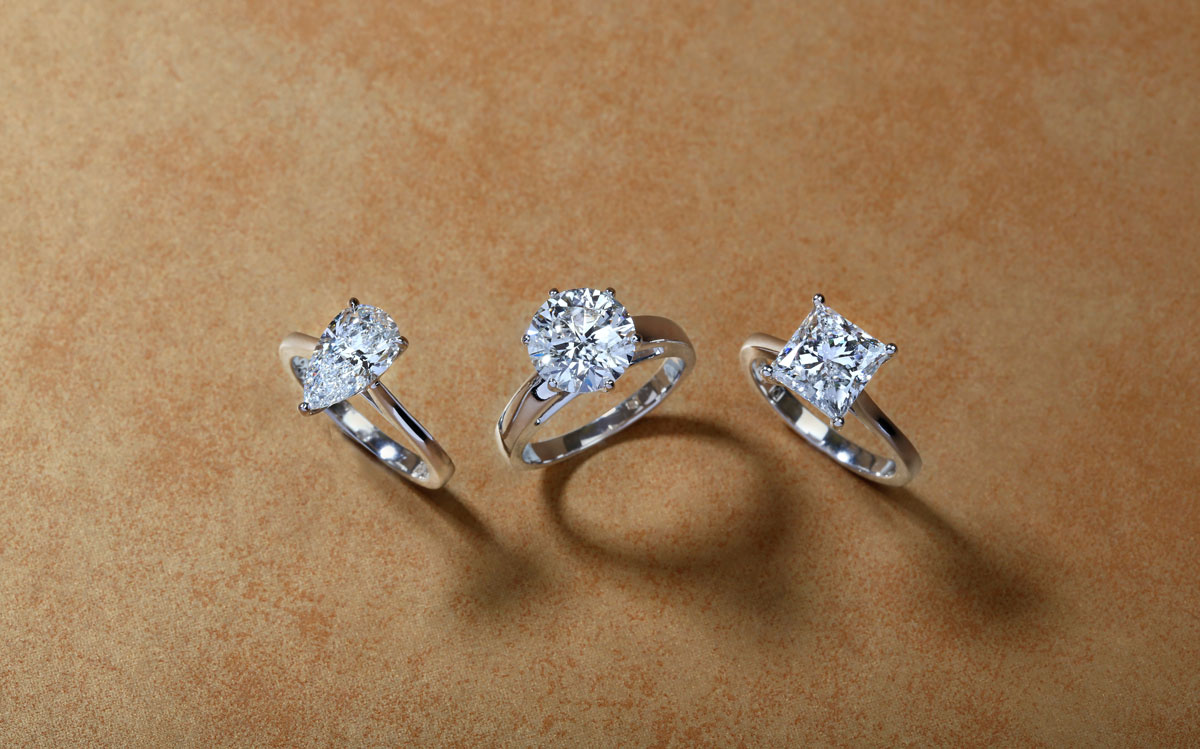Choosing the right diamond shape is more than a matter of personal taste; it’s a decision that can significantly impact the diamond’s appearance, brilliance, and price. From the classic round diamond cut to the elegant oval, each shape offers unique characteristics that cater to different styles and preferences.
In this guide, we’ll explore the most popular diamond shapes, providing you with the practical knowledge you need to find the perfect gemstone for your next piece of jewellery. This guide is especially useful for those on the journey to find the perfect engagement ring. Whether you’re a first-time buyer or looking to upgrade an existing piece, understanding diamond shapes will empower you to make an informed decision that aligns with your taste, budget, and the preferences of your loved one.
- Introduction to Diamond Shapes
- A Detailed Guide to Popular Diamond Shapes
- Choosing the Best Diamond Shape for Your Engagement Ring
Introduction to Diamond Shapes
Diamond shapes refer to the appearance of a diamond when viewed from above – it’s what we see when the stone is mounted in a piece of jewellery.
Unlike the cut, which determines how well the diamond reflects light, the shape is about the overall form and outline of the stone.
The shape you choose can influence the diamond’s brilliance, size perception, and even its suitability for different jewellery settings. It’s often the first thing people notice, making it a vital aspect to consider when selecting a diamond.
Why Diamond Shape Matters
Although it isn’t one of the traditional 4Cs of diamonds, choosing a diamond shape is one of the things that will make the biggest difference to what your jewellery will look like.
Different shapes can highlight various aspects of the diamond, such as its clarity, colour, or brilliance. For example, an emerald cut emphasises clarity, while a round brilliant is prized for its sparkle.
The shape can also affect the perceived size of the diamond, with elongated shapes like oval and marquise often appearing larger than their actual carat weight.
Moreover, the shape can resonate with personal symbolism , making it a significant factor in choosing a diamond that reflects the wearer’s individual taste and style.
A Brief Overview of the Most Popular Diamond Shapes
- Round: The most popular shape, known for its brilliance and versatility.
- Princess: A square shape with sharp edges, offering a modern look.
- Oval: An elongated shape that can create the illusion of greater size.
- Marquise: A boat-like shape with pointed ends, often considered unique and elegant.
- Emerald: A rectangular shape with step cuts, known for its understated glamour.
The Difference Between Diamond Shape and Diamond Cut
While the shape of a diamond describes its physical form, diamond cut refers to how well the diamond has been crafted from its rough state, and is graded on a scale from ‘Poor’ to ‘Excellent’.
Diamond cut involves precise angles, proportions, and symmetry, affecting how the diamond reflects light and sparkles.
Where this gets even more confusing is that some diamond shapes include ‘cut’ in their name e.g. princess cut, cushion cut, Assher, cut, etc. However, to be clear:
- Shape: Refers to the geometric appearance of the diamond (e.g., round, oval, heart).
- Cut: Relates to the craftsmanship, including the angles and proportions that determine how the diamond reflects light and therefore how much it will sparkle.
A Detailed Guide to Popular Diamond Shapes
Diamonds come in a wide range of shapes, each with its unique charm and characteristics. So, let’s explore the 10 most popular diamond shapes, delving into their descriptions, characteristics and visual appeal. Whether you’re looking for a classic or contemporary style, understanding these popular diamond shapes will guide you in finding the perfect gemstone for your engagement ring or other piece of jewellery.
Round Diamond
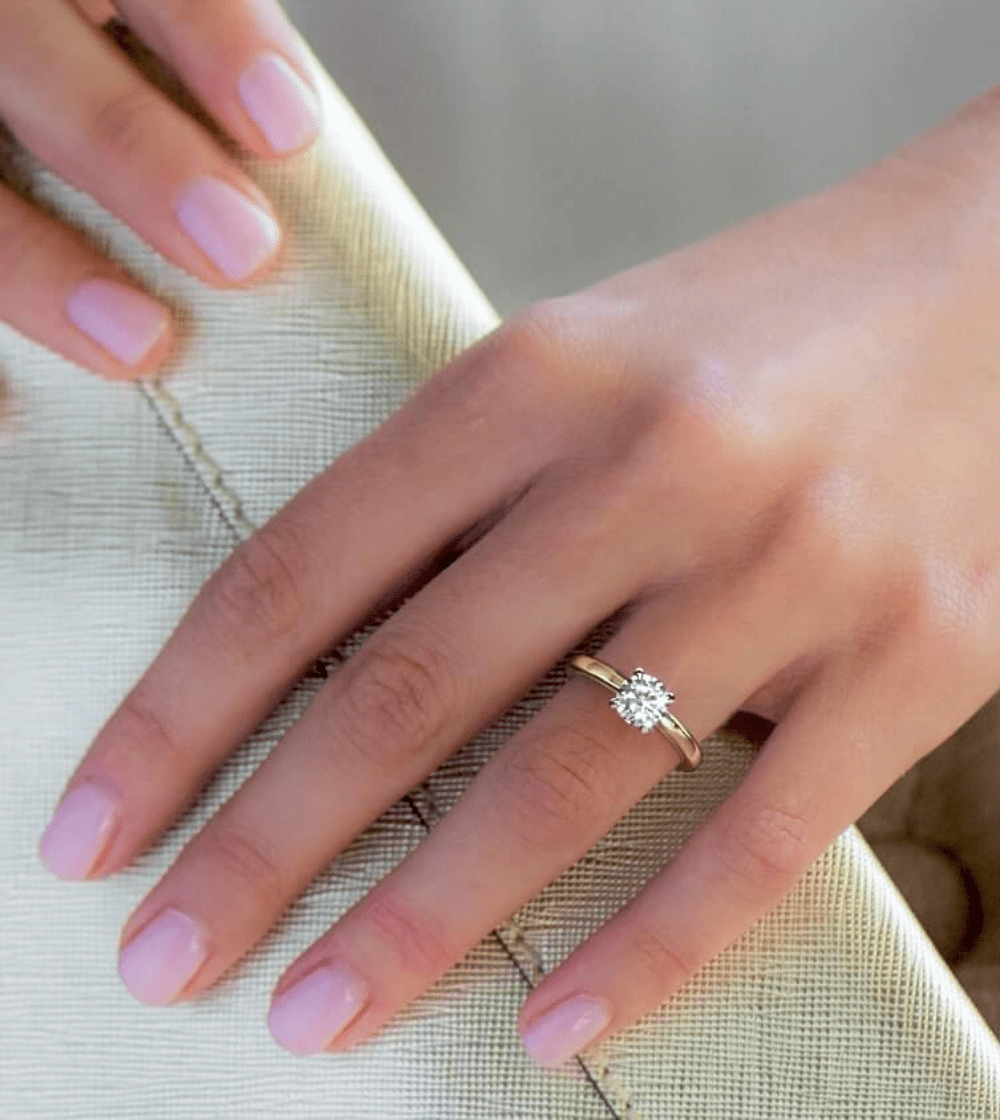
The round diamond, more properly known as the round brilliant cut diamond, stands as a timeless symbol of elegance and sophistication. Its enduring popularity and universal appeal make it a popular choice for engagement rings.
The round diamond is renowned for its perfect symmetry and 58 precisely cut facets. Its shape is designed to maximise the reflection of light, creating unparalleled sparkle and brilliance that outshines all other diamond shapes. The round shape is not only aesthetically pleasing but also versatile, complementing various settings and styles.
Historical Background
The round shape has a rich history that dates back to the early 18th century. The “old European cut,” a precursor to the modern round brilliant, was popular during the Victorian, Edwardian, and Art Nouveau eras. However, the modern round brilliant cut owes its existence to Marcel Tolkowsky’s groundbreaking work in 1919.
A mathematician and diamond cutter, Tolkowsky published his thesis “Diamond Design,” where he explained the ideal angles and proportions for achieving maximum brilliance and dispersion in a round diamond. His work laid the foundation for the modern round brilliant cut, setting the standard for what is considered the “ideal cut” today. Tolkowsky’s precise calculations focused on balancing the depth and table size, crown and pavilion angles, and other factors to create a cut that captures and reflects light most effectively.
Popularity and Use in Engagement Rings
The round brilliant’s timeless elegance and exceptional sparkle have made it the preferred choice for engagement rings.
Representing over 60% of all diamonds sold, the round shape is often associated with tradition, romance, and eternal love. Its versatility allows it to blend seamlessly with various ring settings, from classic solitaires to intricate vintage designs. The round diamond’s ability to enhance sparkle and size perception makes it a popular choice for those seeking a statement piece that embodies both grace and glamour.
Cushion Cut
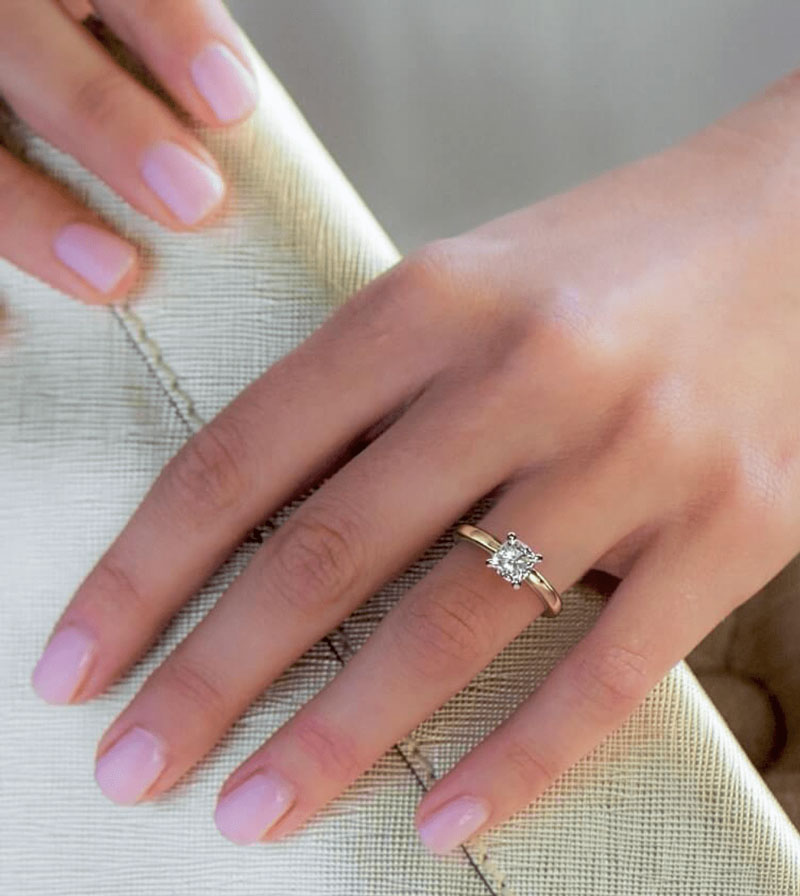
The cushion cut, a timeless and romantic diamond shape, has charmed generations with its soft, rounded edges and brilliant sparkle. Known for its classic appeal and unique spin on the traditional round brilliant, the cushion cut has a rich history that spans over 200 years.
Also known as the “pillow-cut diamond,” it’s characterised by its square or rectangular shape with rounded corners, resembling a pillow, hence the name of the cut. Its unique faceting pattern, often with larger facets, allows for a greater dispersion of light, creating a mesmerising sparkle. The cushion cut typically consists of 58 to 64 facets, and its soft, romantic appearance has made it a beloved choice for vintage-inspired jewellery.
The cushion cut’s ability to capture and reflect light in a distinctive way sets it apart from the more traditional round brilliant, offering a softer, more romantic glow.
Historical Background of cushion cut diamonds
The cushion cut’s origins can be traced back to the early 19th century, when it was known as the “old mine cut.” Over the years, refinements in cutting techniques and technology have led to variations in the cushion cut, enhancing its brilliance and appeal.
The cushion cut’s recent resurgence in popularity can be attributed to its vintage charm, versatility, and unique spin on the classic round brilliant. Celebrities and trendsetters have embraced the cushion cut, contributing to its renewed interest and demand.
Oval Cut Diamonds

The oval cut, a harmonious blend of elegance and brilliance, offers a contemporary twist on the classic round brilliant. Known for its elongated shape and captivating sparkle, the oval cut has become a sought-after choice for those seeking a diamond that combines tradition with modernity.
It’s characterised by its elongated, symmetrical shape, with a similar faceting pattern to the round brilliant. Its elongated design creates an illusion of greater size, making the oval diamond appear larger than other cuts of the same carat weight. The oval cut diamond typically consists of 56 to 58 facets, offering a brilliant sparkle that emphasises the diamond’s length and symmetry. Its slender shape accentuates the finger, adding a touch of elegance and flair.
The oval cut’s elongated shape and brilliant sparkle make it a versatile choice for various jewellery settings. Its graceful curves complement different finger shapes, and its ability to maximise perceived size adds to its appeal.
Historical Background of oval diamonds
The oval cut’s origins can be traced back to the 1960s when it was created by the renowned diamond cutter Lazare Kaplan. Building on the principles of the round brilliant, Kaplan introduced the oval cut as a modern and innovative alternative. The cut’s graceful curves and brilliant sparkle quickly gained popularity, and it has since become a beloved choice for engagement rings, earrings, and other fine jewellery.
Considerations When Choosing an Oval Cut
When selecting an oval cut diamond, it’s essential to consider the length-to-width ratio, symmetry, and the potential “bow-tie” effect.
A well-proportioned oval cut will have a balanced length-to-width ratio, typically between 1.35 and 1.50, ensuring a harmonious appearance. Symmetry is vital, as any misalignment can affect the diamond’s overall beauty. Additionally, some oval cuts may exhibit a “bow-tie” shadow across the centre, so careful inspection is necessary to choose a diamond with minimal or no bow-tie effect.
Radiant Cut diamonds

Blending brilliance and modernity, the radiant cut stands out with its unique faceting pattern and captivating sparkle. Known for its rectangular or square shape with cut corners, the radiant cut offers a contemporary and vibrant option for those seeking a diamond that combines the best of both round and emerald cuts.
It’s characterised by its rectangular or square shape with cut corners, creating a distinctive and elegant appearance. Its unique faceting pattern, combining the brilliant faceting of a round cut with the step-cut faceting of an emerald cut, allows for extraordinary sparkle and depth. The radiant cut typically consists of 70 facets, offering a dazzling brilliance that emphasises the diamond’s shape and size. Its cut corners add a touch of sophistication and reduce the risk of chipping, making it a practical and stylish choice.
The radiant cut’s rectangular or square shape and brilliant sparkle make it a versatile choice for various jewellery settings. Its distinctive faceting pattern complements different styles, from contemporary to vintage-inspired designs. The radiant cut’s lively brilliance resonates with those seeking a diamond that reflects individuality and flair.
Historical Background of radiant cut
The radiant cut’s origins can be traced back to the 1970s when it was created by the master diamond cutter Henry Grossbard. Seeking to combine the brilliance of the round cut with the geometric elegance of the emerald cut, Grossbard introduced the radiant cut as a groundbreaking and innovative option. The cut’s unique design and brilliant sparkle quickly gained popularity, and it has since become a beloved choice for those seeking a diamond that reflects modernity and vibrancy.
Considerations When Choosing a Radiant Cut
When selecting a radiant cut diamond, it’s essential to consider the length-to-width ratio, symmetry, and overall proportions.
A well-proportioned radiant cut will have a balanced appearance, ensuring a harmonious blend of brilliance and elegance. Symmetry is vital, as any misalignment can affect the diamond’s overall beauty. Additionally, the radiant cut’s unique faceting pattern requires careful inspection to choose a diamond that maximises brilliance and depth.
Princess Cut
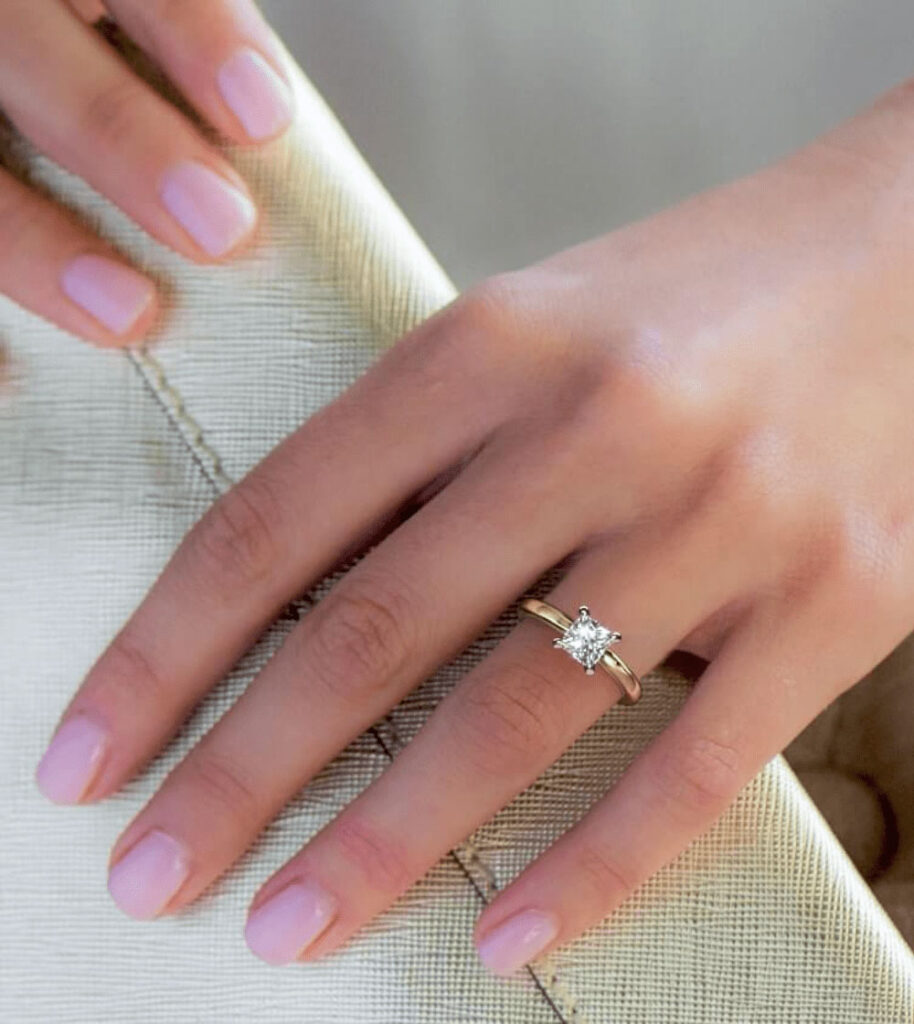
The princess cut, with its modern flair and geometric precision, has become a favourite among those seeking a contemporary and distinctive diamond shape.
It’s known for its square or slightly rectangular shape with sharp, uncut corners. It typically consists of 58 facets, similar to the round brilliant, but arranged in a way that emphasises the diamond’s depth and creates a unique play of light. The princess cut is often chosen for its ability to retain more of the rough diamond, making it a cost-effective option without compromising brilliance. One of the defining characteristics of the princess cut is the edges of the diamond, which are often chamfered to prevent chipping.
Historical Background of the Princess Cut
The princess cut is a relatively new addition to the world of diamond shapes, with its origins tracing back to the 1960s. Created by Arpad Nagy, a London diamond cutter, the “Profile Cut” was the first iteration of what would become the princess cut. Over the years, the cut was further refined and evolved, leading to the modern princess cut we know today. Unlike traditional cuts that have centuries of history, the princess cut’s contemporary origin reflects its modern appeal and innovative design.
Why Princess Cuts are Among the Most Popular Fancy Shapes
The princess cut’s geometric precision and clean lines make it a favourite among those seeking a modern and chic look. Its symmetrical shape and distinct faceting pattern create a vibrant sparkle, making it a standout choice for engagement rings, earrings, and other jewellery pieces.
Moreover, its versatile design allows it to complement various settings, from minimalist solitaires to elaborate halo designs, while the cut’s efficiency in retaining rough diamond weight makes it a value-driven choice.
The princess cut’s unique combination of brilliance and modern aesthetics has made it a preferred option for those seeking a fresh and fashionable alternative to traditional shapes.
Emerald Cut diamonds

The emerald cut, known for its understated glamour and architectural beauty, is a diamond shape that exudes elegance and sophistication.
It’s characterised by its rectangular shape with truncated corners, creating an effect that resembles a staircase or hall of mirrors. Unlike brilliant cuts that focus on maximising sparkle, the emerald cut emphasises clarity and the interplay of light and shadow. Its long, parallel facets create broad flashes of light, showcasing the diamond’s depth and transparency. The emerald shape has a large table and open facets that require high clarity, as inclusions and imperfections are more visible in this cut.
The emerald cut’s glamour lies in its simplicity and refinement. Its elongated shape and step-like facets create a subtle play of light, offering a sophisticated sparkle rather than an intense brilliance. The emerald cut’s understated glamour appeals to those who appreciate grace and elegance, making it a timeless choice that transcends fleeting trends.
Historical Background of emerald cut diamonds
The emerald cut is one of the oldest diamond shapes. It has a rich history that dates back to the 1500s, when it was initially used for cutting emeralds, hence the name. The cut evolved over time, and by the 1920s, it became synonymous with the Art Deco movement.
Suitability for Art Deco-Inspired Styles
The emerald cut’s clean lines and geometric precision make it a perfect match for Art Deco-inspired styles. Its architectural beauty and vintage charm align with the design principles of the Art Deco era, characterised by bold geometry and ornamental aesthetics. Whether set in a solitaire or paired with accent stones, the emerald cut’s suitability for Art Deco designs adds a touch of historical elegance and modern flair to any jewellery piece.
Asscher Cut
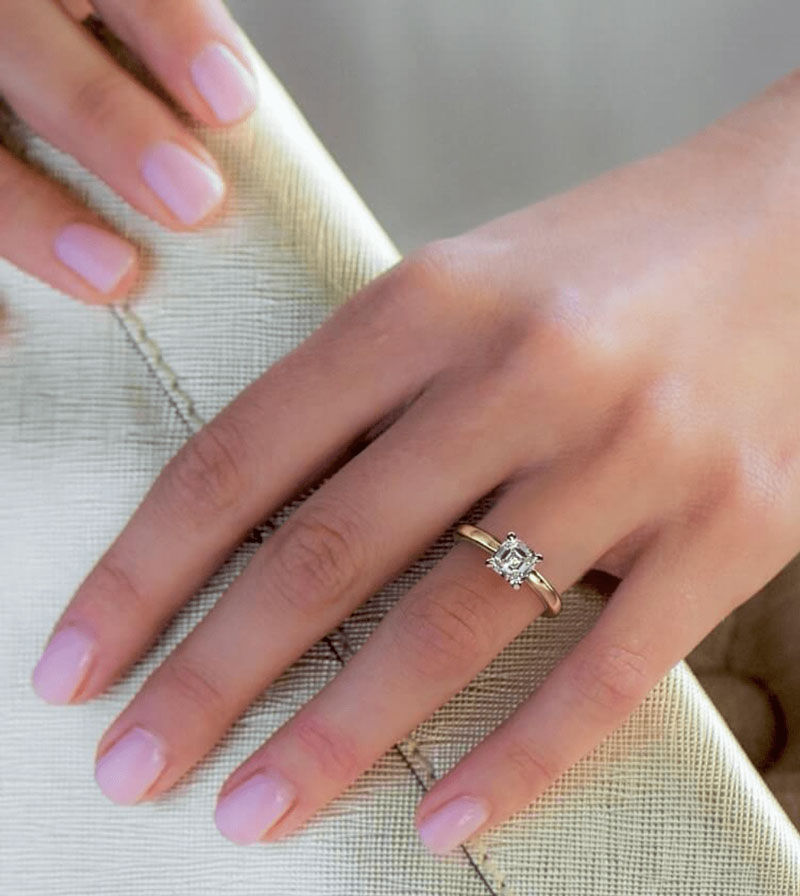
The Asscher cut, a captivating and historically significant diamond shape, offers a unique blend of vintage charm and modern elegance.
It’s characterised by its square shape with deeply truncated corners, creating an almost octagonal appearance. Its unique faceting pattern, with parallel step facets, creates a mesmerising “hall of mirrors” effect, where the interplay of light and shadow draws the eye into the diamond. The Asscher cut diamond typically consists of 58 facets, and its high crown and small table emphasise the diamond’s depth, offering a distinctive sparkle.
Historical Background
The Asscher cut was introduced in 1902 by Joseph Asscher and Abraham Asscher, renowned diamond cutters from Holland. The Asscher Brothers were known for their innovation and craftsmanship, and the Asscher cut was a groundbreaking creation that set a new standard for diamond cutting. The original Asscher cut was patented to protect its unique design, and it quickly gained popularity during the Art Deco period. In 2001, the cut was updated to include more facets, enhancing its brilliance and appeal.
Cousin of the Emerald Cut
The Asscher cut is often considered a cousin to the emerald cut, sharing similar step-like facets and an emphasis on clarity. In fact, on a grading report, you won’t see the description ‘Asscher cut’, instead it will say ‘Square modified emerald cut’, which is the more proper name for the Asscher.
While both cuts offer a “hall of mirrors” effect, the Asscher cut’s square shape and higher crown distinguish it from the more elongated emerald cut. The relationship between the Asscher cut and emerald cut reflects a shared appreciation for geometric precision and understated elegance, making both cuts timeless choices for jewellery.
Marquise Cut

he marquise cut, with its distinctive elongated shape and pointed ends, offers a unique and elegant choice for those seeking a diamond that stands out. Known for its ability to elongate the finger and maximise carat weight, the marquise cut has a rich history and a timeless appeal.
Also known as the “navette” cut, it’s characterised by its elongated oval shape with pointed ends. Its unique design creates an illusion of greater size, making the marquise diamond appear larger than other cuts of the same carat weight. The marquise cut typically consists of 58 facets, offering a brilliant sparkle that emphasises the diamond’s length and symmetry. Its slender shape accentuates the finger, adding a touch of elegance and flair.
Historical Background
The marquise diamond has a fascinating history that dates back to the 18th century. It is said to have been created for King Louis XV of France, who wanted a diamond cut to resemble the lips of his mistress, the Marquise de Pompadour. The cut’s royal origin and romantic association have contributed to its enduring popularity and prestige.
Heart Shaped Diamond
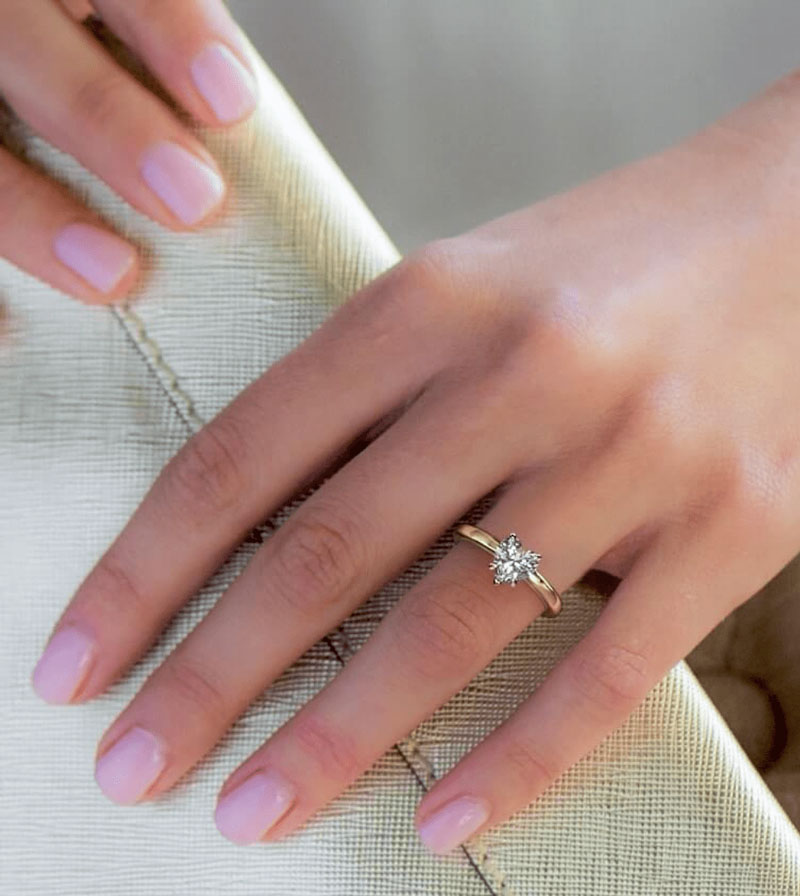
he heart shape, a symbol of love and romance, offers a unique and sentimental choice for those seeking a diamond that embodies affection and connection. Known for its distinctive heart-shaped silhouette, this cut has become a favoured option for romantic gestures and special occasions.
It’s characterised by its iconic heart shape, with a cleft at the top and a pointed tip at the bottom. Its unique design requires precise craftsmanship to achieve a symmetrical and balanced appearance. The heart shape typically consists of 56 to 58 facets, offering a brilliant sparkle that emphasises the diamond’s romantic silhouette. Its slender curves and distinctive form make it a symbol of love and devotion, adding a touch of sentimentality to any piece of jewellery.
The heart shape’s iconic design and brilliant sparkle make it a meaningful choice for various jewellery settings. Its graceful curves complement different styles, from classic to contemporary designs.
Historical Background
The heart shape’s origins are shrouded in mystery, with references dating back to the 16th century. It has been associated with royalty and nobility, symbolising love and affection in various cultures. The heart shape gained prominence in the modern era as a romantic and expressive choice, reflecting deep emotional connections and commitment.
Considerations When Choosing a Heart Shape
When selecting a heart shaped diamond, it’s essential to consider the symmetry, proportions, and overall balance.
A well-proportioned heart shape will have a balanced appearance, with even curves and a distinct cleft. Symmetry is vital, as any misalignment can affect the diamond’s overall beauty. Additionally, the heart shape’s unique design requires careful inspection to choose a diamond that maximises brilliance and captures the essence of love and romance.
Pear Shape
The pear shape, often referred to as the “teardrop” shape, is a unique and elegant diamond cut that combines the brilliance of a round cut with the elongated elegance of a marquise. Known for its distinctive silhouette, the pear shape offers a graceful and sophisticated option for those seeking a diamond that embodies both classic charm and modern flair.
It’s characterised by its unique pear shape, with a rounded bottom and a pointed tip. Its asymmetrical design requires precise craftsmanship to achieve a balanced and harmonious appearance. The pear shape typically consists of 58 facets, offering a brilliant sparkle that emphasises the diamond’s graceful silhouette. Its elongated form creates an illusion of length, making it a flattering choice for various finger shapes.
The pear shape’s distinctive design and brilliant sparkle make it a versatile choice for various jewellery settings. Its graceful curves complement different styles, from vintage to contemporary designs.
Historical Background
The pear shape’s origins can be traced back to the 15th century when it was created by the renowned diamond cutter Lodewyk van Bercken. Known for his innovative techniques, van Bercken introduced the pear shape as a groundbreaking option that combined the best of both round and marquise cuts. The cut’s unique design and brilliant sparkle quickly gained popularity, and it has since become a beloved choice for those seeking a diamond that reflects elegance and individuality.
Considerations When Choosing a Pear Shape
When selecting a pear shaped diamond, it’s essential to consider the length-to-width ratio, symmetry, and overall proportions. A well-proportioned pear shape will have a balanced appearance, ensuring a harmonious blend of brilliance and elegance. Symmetry is vital, as any misalignment can affect the diamond’s overall beauty. Additionally, the pear shape’s unique design requires careful inspection to choose a diamond that maximises brilliance and captures the essence of grace and style.
Other Diamond Shapes You May See
Let’s explore some other types of diamond shapes, ones that cater to individual tastes and preferences. These shapes, often referred to as “fancy shapes,” offer a distinctive and creative alternative for those seeking a diamond that reflects their personality and style.
- Mine Cut: The mine cut, also known as the old mine cut, is a historical diamond shape that dates back to the 18th century. Characterised by its cushion-like square shape with rounded corners, the mine cut offers a soft and romantic appearance. Its large facets and open culet provide a distinctive sparkle, reflecting a vintage charm that resonates with history and tradition.
- Square Diamond: The square diamond, with its symmetrical and balanced shape, offers a modern and sleek option. Its precise angles and clean lines provide a contemporary elegance that complements various styles. The square shape’s brilliance and simplicity make it a versatile choice for those drawn to geometric beauty and modern sophistication.
- Fancy Shape Diamonds: Fancy shape diamonds encompass a wide range of unique and unconventional shapes, from kite-shaped to shield-shaped diamonds. These shapes provide an opportunity to express individuality and creativity, offering a refreshing alternative to traditional cuts. Fancy diamond shapes may vary in design, reflecting artistic flair and innovative craftsmanship.
- Other Uncommon Shapes: The world of diamonds is rich with creativity and innovation, and various other shapes may capture the imagination. From triangular trilliant cuts to hexagonal shapes, these less common forms provide a glimpse into the artistic possibilities of diamond cutting. Each unique shape reflects a blend of craftsmanship, innovation, and personal expression.
Choosing the Best Diamond Shape for Your Engagement Ring
Selecting the perfect diamond shape for an engagement ring is an important decision that requires thoughtful consideration and understanding of various factors. Let us guide you through the essential aspects of choosing the best diamond shape, focusing on personal preferences, budget considerations, and the unique characteristics of different shapes.
- Personal Taste: Your or your partner’s personal style and preference play a crucial role in selecting the diamond shape. Whether you prefer a classic round shape or a unique fancy shape, understanding personal taste is paramount.
- Budget Considerations: Different shapes come with varying price tags. Knowing your budget can guide you towards shapes that offer the best value for money without compromising on beauty and quality.
- Ring Style Compatibility: The diamond shape should complement the ring’s overall design and style. For example, a diamond with cut corners may suit a vintage setting, while a radiant cut diamond is a popular choice for modern designs.
- Face-up Size Consideration: Some shapes create the illusion of a larger face-up size, offering more visual impact. Understanding this aspect can help you maximise the appearance of the diamond within your budget.
How Shape Affects Price
The shape of a diamond significantly influences its price. Here’s how:
- Cutting Process: The way a diamond is cut can lead to variations in price. Some shapes require more intricate cutting techniques, which affects the overall cost.
- Demand and Supply: Popular shapes may command higher prices due to demand, while less common shapes might offer better value for money.
- Wastage: Some shapes result in more wastage of the rough diamond during the cutting process, contributing to a higher price.
To illustrate the difference in price between different diamond shapes, we’ll compare the pricing of 1-carat, G colour diamonds with VS2 clarity from Blue Nile:
| Diamond shape | Price (£) | Difference (£) | Difference % |
|---|---|---|---|
| £3,902 | |||
| Pear | £3,803 | £99 | 3% |
| Marquise | £3,671 | £231 | 6% |
| Heart | £3,095 | £807 | 21% |
| Oval | £3,029 | £873 | 23% |
| Princess | £2,865 | £1,037 | 27% |
| Asscher | £2,791 | £1,111 | 29% |
| Emerald | £2,733 | £1,169 | 30% |
| Radiant | £2,708 | £1,194 | 31% |
| Cushion | £2,461 | £1,441 | 37% |
It’s important to understand that these price differences will likely differ depending on the carat weight, clarity and colour that you are looking for, but it’s a good indication of the scale of the difference between different shapes and could inform your decision on what shape to choose.
For example, if you are looking for a square-shaped diamond ring, choosing a square cushion cut over a princess cut could save you significant amounts of money.
Length-to-Width Ratio in Diamond Shapes
The length-to-width ratio in diamond shapes is a simple yet crucial measurement that can greatly influence a diamond’s appearance. It’s calculated by dividing the length of the diamond by its width.
For example, a round diamond typically has a ratio of 1:1, meaning it’s as long as it is wide. In contrast, an elongated shape like the marquise might have a ratio of 2:1. This ratio helps in understanding the diamond’s proportion and can guide you in choosing a shape that suits your style. Whether you prefer a more slender or balanced look, the length-to-width ratio is a key factor to consider.
Final thoughts on diamond shape:
Choosing the right diamond shape is a pivotal decision in the journey towards finding the perfect engagement ring. The shape of a diamond is more than a mere aesthetic choice; it’s a reflection of individual style, a determinant of value, and a significant factor in the overall appearance of the ring.
Remember, there’s no one-size-fits-all approach when it comes to diamond shapes for engagement rings. Each shape has its unique characteristics and charm. Whether you’re drawn to the elegance of the emerald cut or the romance of the heart shape, the choice is deeply personal and should resonate with your taste and love story.
So, take your time, explore the different diamond shapes and cuts, and choose the one that speaks to you.
